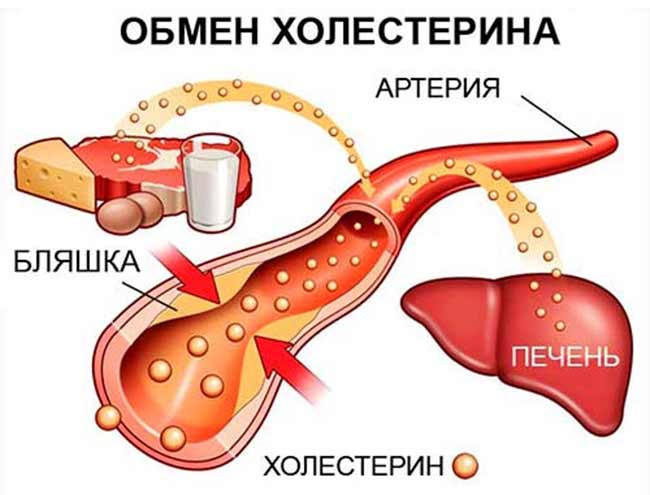In order for the heart not to malfunction, along with an active lifestyle, rejection of bad habits, the ability to cope with stress, there is a rational diet and control over the total cholesterol numbers - the norm is below 5.6 mmol / l. Cholesterol monitoring should be started early, at a young age. Even if your heart is working well at the moment, there are no prerequisites for future problems.
- The rate of cholesterol in the blood
- 1. Calorie intake and expenditure must be balanced
- 2. Vitamins, potassium and magnesium are necessary for the normal functioning of the heart.
- 3. Pure drinking water is the most ideal drink for the heart
- With high cholesterol, it is recommended to exclude from the diet
The rate of cholesterol in the blood
Cholesterol (cholesterol) is a fat-like substance necessary for the human body. However, if its total values exceed the norm (3.2-5.6 mmol / l), it begins to be deposited in the walls of the arteries, forming atherosclerotic plaques.
Over time, the plaques increase in size, significantly narrowing or even completely blocking the lumen of the vessel. Blood flow to the heart is dramatically reduced, which leads to chest pain and even heart attack.
Not only the heart suffers, but also the arteries of the lower extremities. brain. The main goal of lowering cholesterol is to reduce the risk of heart disease.

Raising bad cholesterol and lowering good cholesterol are life-threatening. For reference.
- Dyslipidemia - violation of lipid metabolism associated with an increase in the level of "bad" cholesterol (LDL) and a decrease in "good" (HDL).
- LDL - low density lipoproteins, this is the main reason for the formation of atherosclerotic plaques - N up to 3.5 mmol / l. It is important that the higher this indicator, the higher the risk of illness.
- HDL - high strength lipoproteins, prevent the formation of atherosclerotic plaques - N> 0.9 mmol / l. It is important that the higher this indicator, the lower the risk of illness.
- Triglecides - neutral fats.

Correction of lipid metabolism disorders is not based on drug therapy - it is a healthy lifestyle: diet, body weight correction, increased physical activity, rejection of bad habits.
The main goal of drug therapy is to reduce the level of "bad or bad" cholesterol - LDL. The doctor will help you with the choice of drugs if he sees that a healthy lifestyle does not lead to the desired results. These drugs are usually taken for a long time. What are the principles of correcting lipid metabolism disorders?
1. Calorie intake and expenditure must be balanced
Limit your fat intake to around 30% of your calories. At a normal weight for men 70-90 g, for women 50-60 g per day. It is important to limit unhealthy fats - these are animal and hydrogenated.
Opt for flaxseed oil - the best plant source of omega-3 fatty acids, it reduces the absorption of cholesterol.
Most of the daily diet should be carbohydrates from vegetables, fruits, grain products containing a lot of fiber, including water-soluble fiber, which removes cholesterol, and the consumption of simple carbohydrates (sugar, honey) should be reduced.
Protein: fish, chicken, turkey, very lean meat, seafood should be at least 10-20% of calories - 100-120 g per day, including vegetable, which are rich in legumes - lentils, by the way, remember the last time you took it ate and beans, peas, nuts, seeds, bran.
2. Vitamins, potassium and magnesium are necessary for the normal functioning of the heart.
Trace elements maintain a normal heart rate and lower blood pressure.A high percentage of potassium and magnesium is found in dried apricots, raisins, persimmons, prunes, broccoli, dried and fresh herbs, seaweed, beets, onions, sea fish, celery - this product is in the top 150 most useful.
Try this recipe.
In a bowl, combine the low sodium tuna (salt),
1 tablespoon balsamic vinegar
1/4 Art. finely chopped onion,
1/4 Art. finely chopped apple,
1 tablespoon of homemade mayonnaise and some ground pepper. Then add the prepared mixture with a spoon to the celery stalks. Tasty, satisfying and healthy.
3. Pure drinking water is the most ideal drink for the heart
A great addition will be compotes from fresh and dry fruits, rosehip decoction, natural juices, chicory drinks, green tea and low-fat fermented milk drinks.
- 4. Watch out for salt - it must be limited. Remember that there is a lot of hidden salt around, found in industrial products.
- 5. Cook food correctly - stew, boil, bake, but do not fry. No matter how beautiful and appetizing fried dark meat looks, people with high cholesterol should definitely refrain from it.
- 6. Plan ahead, create a daily menu to avoid consuming "unhealthy" foods.
- 7. Physical activity is an important starting point for lowering cholesterol. In other words, move more!
- 8. Herbal medicine.
It is quite difficult to find plants that would act equally effectively on everyone. However, it is worth paying attention to herbs and plants that improve the nutrition of the heart muscle, soothe, and are rich in cardiac glycosides.
These include spring adonis, oleander, lily of the valley, hawthorn fruits, valerian root, peppermint, medicinal rosemary, blackberry leaves, ordinary hops, anise fruits, hop cones, black chokeberry, burdock, yarrow and others.
With high cholesterol, it is recommended to exclude from the diet
Butter bread, whole milk, fatty cheeses, squid and shrimp, fatty meats, sausages, hot dogs, pates, butter, pastries, ice cream, mayonnaise, salted sauces, coffee and chocolate drinks with cream, tomato juice, canned and frozen foods - semi-finished products.
Along with treatment, the right way of life, do not forget that diet, exercise must be accompanied by a good mood. So indulge yourself from time to time. A wedge of chocolate or a handful of chips will not spoil your healthy diet.


